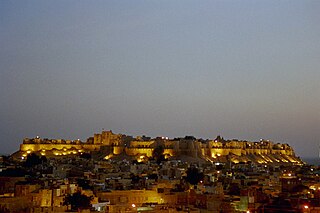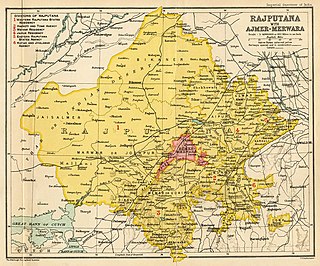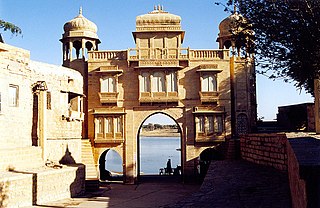See also
- Raval (disambiguation)
- Rawat (disambiguation)
- Rawalpindi, city in Pakistan
- Rawal Express, a Pakistani train service
The Rawal or Raval was a feudal title used by Indian rulers and also a clan of the Rajputs found in the Indian states of Haryana, Uttarpradesh, Rajasthan and Gujrat.

A jagir, also spelled as jageer, was a type of feudal land grant in the Indian subcontinent at the foundation of its Jagirdar (Zamindar) system. It developed during the Islamic era of the Indian subcontinent, starting in the early 13th century, wherein the powers to govern and collect tax from an estate was granted to an appointee of the state. The tenants were considered to be in the servitude of the jagirdar. There were two forms of jagir, one conditional, the other unconditional. The conditional jagir required the governing family to maintain troops and provide their service to the state when asked. The land grant, called iqta'a, was usually for a holder's lifetime; the land reverted to the state upon the death of the jagirdar.
Rajput, also called Thakur, is a large multi-component cluster of castes, kin bodies, and local groups, sharing social status and ideology of genealogical descent originating from the northern part of the Indian subcontinent. The term Rajput covers various patrilineal clans historically associated with warriorhood: several clans claim Rajput status, although not all claims are universally accepted. According to modern scholars, almost all Rajput clans originated from peasant or pastoral communities.

Jaisalmer, nicknamed The Golden city, is a city in the north-western Indian state of Rajasthan, located 575 kilometres (357 mi) west of the state capital Jaipur, in the heart of the Thar Desert. It serves as the administrative headquarters of Jaisalmer district. It is a former medieval trading center and the historic capital of the kingdom of Jaisalmer, founded in 1156 by Rawal Jaisal of the Bhati clan of Rajputs. Jaisalmer stands on a ridge of yellowish sandstone and is crowned by the World Heritage Site, Jaisalmer Fort, a sprawling hilltop citadel supported by 99 bastions. This fort contains a royal palace and several ornate Jain temples. Many of the houses and temples of both the fort and of the town below are built of finely sculptured yellow sandstone. The town has a population, including the residents of the fort, of about 78,000. Jaisalmer ranked 9th on Booking.com's Top 10 The Most Welcoming cities in the world. It is the only Indian city on the list.
Mirza is a multi-ethnic name of Persian origin. It is used as a surname or prefix to identify patriarchal lineage. It is derived from the term Mirzadeh.

Bhati is a Rajput clan that claims descent from a 3rd-century monarch, named Rao Bhati. The Bhati clan historically ruled over several cities in present-day India and Pakistan with their final capital and kingdom being Jaisalmer, India.

Bappa Rawal was a king of the Mewar kingdom in Rajasthan, India. The chronicles consider him to be the founder of the Guhila Rajput dynasty. He is credited with repelling the Arab invasion of India. He is identified as the ruler of the Guhila dynasty, and called by the names Kalabhoja, Shiladitya, and Khumana.

Jadeja is a Samma Rajput clan that inhabits the Indian state of Gujarat and the Tharparkar district of Sindh, Pakistan. They originated from Sammas of Sindh, a pastoral group, and laid a claim on the Rajput identity after marriages with Sodha Rajput women by adopting a process called Rajputisation.

Jaisal Singh (1113–1168) was the founder and first ruler of the Kingdom of Jaisalmer, ruling from 1156 to 1168 CE. Singh was a Rajput chief of the Bhati clan who lived during the 12th century. A direct descendant of Rao Bhati, the 3rd-century Hindu monarch and the common ancestor of the Bhati Rajputs, Singh rose to power in 1143 by defeating his nephew, Rawal Bhojdeo of Lodhruva, in battle and seizing his nephew's position as Rawal.

Jaisalmer Fort is situated in the city of Jaisalmer, in the Indian state of Rajasthan. It is one of the very few "living forts" in the world, as nearly one fourth of the old city's population still resides within the fort. For the better part of its 860-year history, the fort was the city of Jaisalmer. The first settlements outside the fort walls, to accommodate the growing population of Jaisalmer, are said to have come up in the 17th century.

Rājputana, meaning Land of the Rajputs, was a region in the Indian subcontinent that included mainly the present-day Indian state of Rajasthan, as well as parts of Madhya Pradesh and Gujarat, and some adjoining areas of Sindh in modern-day southern Pakistan.

The history of human settlement in the western Indian state of Rajasthan dates back to about 100,000 years ago. Around 5000 to 2000 BCE many regions of Rajasthan belonged as the site of the Indus Valley Civilization. Kalibangan is the main Indus site of Rajasthan, here fire altars have been discovered, similar to those found at Lothal.
Rawat may refer to:

Jaisalmer state is a region of Western Rajasthan state in western India. It lies in the southern part of Thar Desert.

Charan is a caste in South Asia natively residing in the Rajasthan and Gujarat states of India, as well as the Sindh and Balochistan provinces of Pakistan. Historically, Charans have been engaged in diverse occupations like bards, poets, historians, pastoralists, agriculturalists and also administrators, jagirdars and warriors and some even as traders.
Rawal or Raol is a regional variation of the Hindi princely ruler title Raja/Radjah used in some princely states in Rajputana and Western India, and is now also used as a caste designation or surname by several communities in Southern Asia.
The Khanzada Rajputs are a Muslim Rajput community found in the northern part of the Indian subcontinent, particularly in Rajasthan, Haryana and Sindh.
The Guhilas of Medapata colloquially known as Guhilas of Mewar were a Rajput dynasty that ruled the Kingdom of Mewar region in present-day Rajasthan state of India. The Guhila kings initially ruled as Gurjara-Pratihara feudatories between the end of 8th and 9th centuries and later were independent in period of the early 10th century and allied themselves with the Rashtrakutas. Their capitals included Nagahrada (Nagda) and Aghata (Ahar). For this reason, they are also known as the Nagda-Ahar branch of the Guhilas.
Rawal or Raval is an Indian clan of the Rajput community mainly found in Uttarpradesh, Haryana, Rajasthan and Gujarat. They are found in two religions: Hinduism and Sikhism. The Rawal Rajputs were later divided into sub-clans, one of these came to be known as Guhilas or Sisodias of Mewar and Bappa Rawal is considered to be the founder of the Guhila dynasty.
Rawal is a surname of various Indian and Nepali communities. It is mainly found among the Rajputs and Chhetri Nepali Hindus. It was also used as a title before the name by some Rajput rulers. Notable people with include: